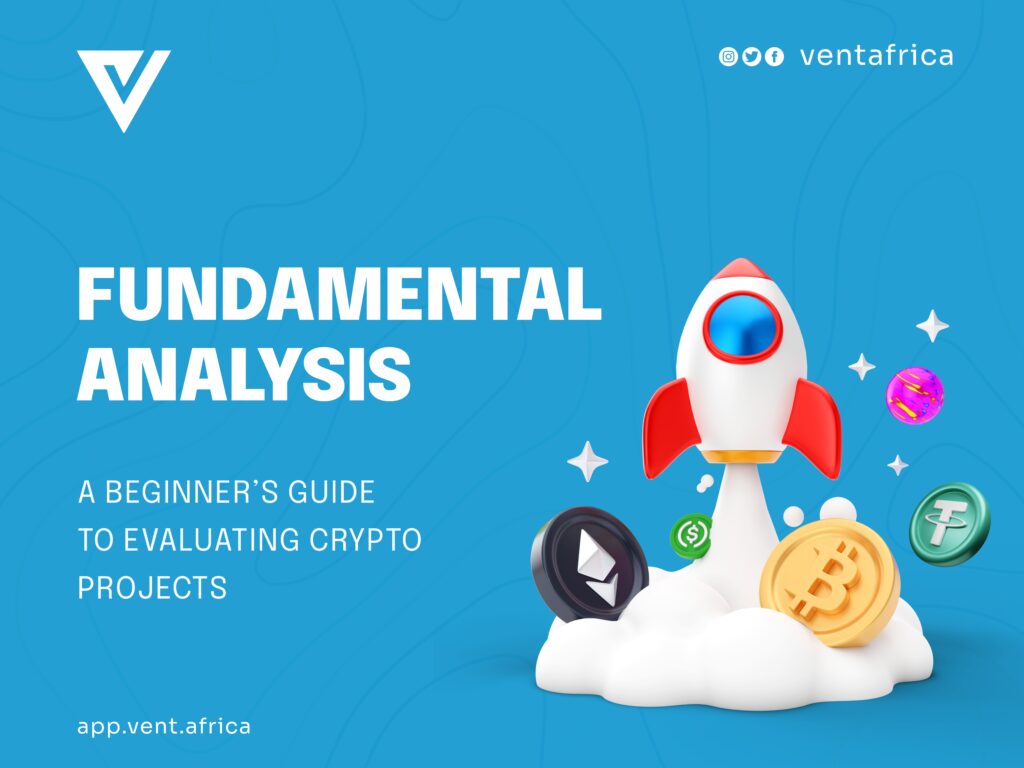Fundamental Analysis: A Beginners’ Guide to Evaluating Crypto Projects
The crypto market is notorious for volatility. Investing in cryptocurrencies, especially newer ones, involves significant risk. As a crypto investor, you must exercise due diligence to understand what you’re investing in through thorough research encompassing all the available metrics and relevant factors. This research process is known as fundamental analysis.
An understanding of fundamental analysis would go a long way in helping you form an educated opinion on whether a cryptocurrency is overvalued or undervalued. Based on your findings, you can determine whether a token is worth buying or selling and even use the information you’ve obtained to develop informed trading strategies that would bolster your chances of profitability.
Sounds great, right? In this article, you’ll learn what fundamental analysis is and how to use it to analyse cryptocurrencies. Let’s dive in!

THE MAIN GIST
- Fundamental analysis is the process of examining the available information about an asset to determine its intrinsic value.
- It helps determine if an asset is overvalued or undervalued and is crucial for long-term investing.
- Factors to consider in crypto fundamental analysis include project metrics, financial metrics, and on-chain metrics.
- Project metrics involve evaluating the team, whitepaper, and community support.
- On-chain metrics such as hash rate, transaction count, transaction value and network fees paid, provide valuable insights into the network’s health and user interest.
- Financial metrics such as market cap and liquidity are important in the assessment of a cryptocurrency’s potential market performance.
- Fundamental analysis allows investors to understand an asset’s true value beyond its market price at any given time.
WHAT IS FUNDAMENTAL ANALYSIS?
Fundamental analysis is a big-picture approach deployed by investors to determine an asset’s intrinsic value by analysing its available information. As the name suggests, it usually involves an evaluation of an asset’s ‘fundamentals’ such as its current use cases, potential real-world application, token economics, user community, or the team behind the project.
Fundamental analysis is the study of these fundamental factors to determine whether they are likely to impact the price of an asset in the future. By carefully examining these internal and external factors, investors can determine whether such an asset is overvalued or undervalued and use their findings to inform trading decisions.
Essentially, it studies what gives a project or asset value. While analysing crypto price charts may provide insights into price movements in the short run, fundamental analysis is vital for long-term investing.
FACTORS TO CONSIDER IN CRYPTO FUNDAMENTAL ANALYSIS
Various factors may be considered during the fundamental analysis of any crypto project. For this post, we shall discuss a few critical factors under the following subheadings:
- Project metrics.
- Financial metrics.
- On-chain metrics.

PROJECT METRICS
Project Metrics include factors such as the team behind the project, the vision and roadmap, the whitepaper, those backing the project, and the community it has. This metric is a valuable pointer to how much work has been done, is being done, and will be done in the long run. By analysing the project metrics, you can make informed predictions on the likelihood of a project’s success.
The Whitepaper
Crypto projects usually release a white paper defining its overall objectives, the problem its advent would solve, and other technical details. Ideally, the whitepaper should clearly define the vision with enough points for investors to understand the problems being solved and the potential user base that would benefit. There should also be a road map with precise and succinct milestones showing the expected trajectory of the project.
It is wise to read a project’s whitepaper before investing in it. You should assess the claims of the whitepaper to see how realistic the goals and promises are. It would be best if you were also on the lookout for any red flags.
Potential Red Flags: A white paper full of generic promises and milestones, with no in-depth details or defined road map.
The Team Behind the Project
You should research the professional experience of the team behind the project before investing in any cryptocurrency. Conducting further research on the persons in a project’s team can give insight into the probability of its success.
You should be able to find details about the team building the project, as well as their expertise, on the ‘About’ or ‘Team’ page of their website. You may conduct further research by looking into the team members on Google or reviewing their LinkedIn profiles. Relevant details to look out for include their professional background or previous projects.
Potential Red Flags: An inexperienced team or a team of anonymous founders (although some projects such as Bored Ape Yacht Club and even Bitcoin have had success despite the anonymity of their founders).
User Community
Another vital factor is how vibrant and active the community is. Looking into the activities of a project’s community can give insight into its chances of success. Successful projects usually have a robust, active and supportive community.
You may join the project’s community forum on Discord or Telegram to learn more about their community. By doing this, you may also interact with other people and gauge their opinion about the project.
You may also check out their social media engagement to see whether the project’s community is genuine. It is a red flag if a project has tons of followers but only a few likes or comments.
Potential Red Flags: Little engagement or no meaningful discussions on community forums.
Tokenomics
Tokenomics (token + economics) encompasses a given cryptocurrency’s distribution, circulation, and total supply. The ‘circulating supply’, ‘total supply’ and ‘maximum supply’ are essential data points to evaluate because they affect the overall price of cryptocurrencies, reflecting the forces of supply and demand. Crypto projects usually have an uneven token distribution process through which supply substantially increases over time. It is essential to review and understand the distribution process of a cryptocurrency before investing in it because the unlocking of new tokens usually comes with the risk of a significant price drop.
You may also consider how the funds were initially distributed. Where the initial distribution is through an ICO, the whitepaper should outline how much is reserved for the team and what would be left for investors. On the other hand, where users earn the token by mining, you may look into the asset’s creator’s pre-mining records on the network before it was announced. Observe whether the tokens are distributed fairly and transparently.
Potential Red Flags: If most of the supply is owned by a few entities, those entities may easily manipulate the market.

ON-CHAIN METRICS
On-chain Metrics provide insight into what’s going on behind the scenes. They can be observed by looking at the data available on the blockchain. However, for convenience, you may pull the relevant information from websites or APIs (such as CoinMarketCap or Coinmetrics) that provide tools to inform trading decisions.
Hash Rate (PoW) or Total Amount Staked (PoS)
For proof-of-work blockchains, the hash rate is an excellent metric for measuring the network’s health. It refers to the total combined computational power used to mine and process transactions on the blockchain. A higher hash rate makes it more difficult to successfully mount an attack against the network. An increase in the hash rate is an excellent pointer to a growth in interest in mining the said currency. Conversely, reductions in the hash rate are a sign that miners are going offline.
The total amount staked is the hash rate equivalent for Proof-of-stake blockchains. Essentially, how staking works is that users lock their holdings for a set period to participate in block validation. Thus, you can observe the amount staked as a measure of the level of interest in the cryptocurrency at a given time.
Potential Red Flags: A low hash rate or amount staked indicates low interest in the network and also means a lower level of security difficulty.
Transaction Count, Transaction Value and Active Addresses
Transaction count is a measure of activity on a network, as it allows you to see how activity changes over time. On the other hand, the transaction value tells us how much value has been transacted within a period. The active addresses refer to addresses that have sent or received tokens within a certain timeframe. These metrics are great for determining the level of activity on a network over a period.
Potential Red Flags: A low transaction count, transaction value or number of active addresses signals little interest in or demand for the crypto.
Fees paid
An analysis of the network fees being paid can give an insight into the level of demand from users for their transactions to be included on the blockchain. Generally, paying higher fees means the transaction would be placed higher up the mempool and confirmed sooner. Thus, higher fees in a network usually indicate a greater demand for block space in that network.
Potential Red Flags: Lower fees indicate low demand for block space.
FINANCIAL METRICS
Financial Metrics include factors such as market capitalisation and trading volume. Taking a look at these metrics will provide insight into how the cryptocurrency might perform in the future. Thus, it could be useful in determining whether or not buying or selling it at that moment is the right decision.
Market Cap
Market capitalisation is a metric used to calculate a network’s total value by multiplying the asset’s current price by its circulating supply. It is a useful indicator of the growth potential of a cryptocurrency. One common view among crypto holders is that coins with smaller caps have a higher growth potential than those with already large caps. On the other hand, other investors believe that coins with large caps have more robust networks and better infrastructure, giving them the edge over those with smaller caps.
Liquidity
Liquidity is a measure of how easily an asset can be bought or sold. When an asset is liquid, selling it at its trading price would be easy. However, an illiquid asset would be challenging to sell at a fair price because few buyers are willing to make the trade. A good measure of the liquidity of an asset is its trading volume, as it indicates how much value has been traded within a particular timeframe.
Potential Red Flags: Low liquidity indicates little market interest in a prospective investment. You should proceed cautiously, mainly because getting out of the market might be tricky.
FINAL NOTES
Through fundamental analysis, you can gain valuable insights into cryptocurrencies. Your understanding of FA would also allow you to distinguish the market price from the actual value of an asset. Hopefully, this post will have helped you understand the basics of fundamental analysis and some factors to consider while conducting it. However, don’t forget to do your own further research!
SEAMLESS CRYPTO-TO-CASH CONVERSIONS ON THE GO!
Got crypto you need to convert to fiat on the go? Look no further than Vent Africa! Enjoy the best rates in the market without any fees charged and a dedicated customer support to assist you while trading securely. With Vent Africa, hassles are a thing of the past, and you can enjoy seamless crypto-to-cash deals at your fingertips.
Read more: 5 Reasons to Trade with Vent Africa.

